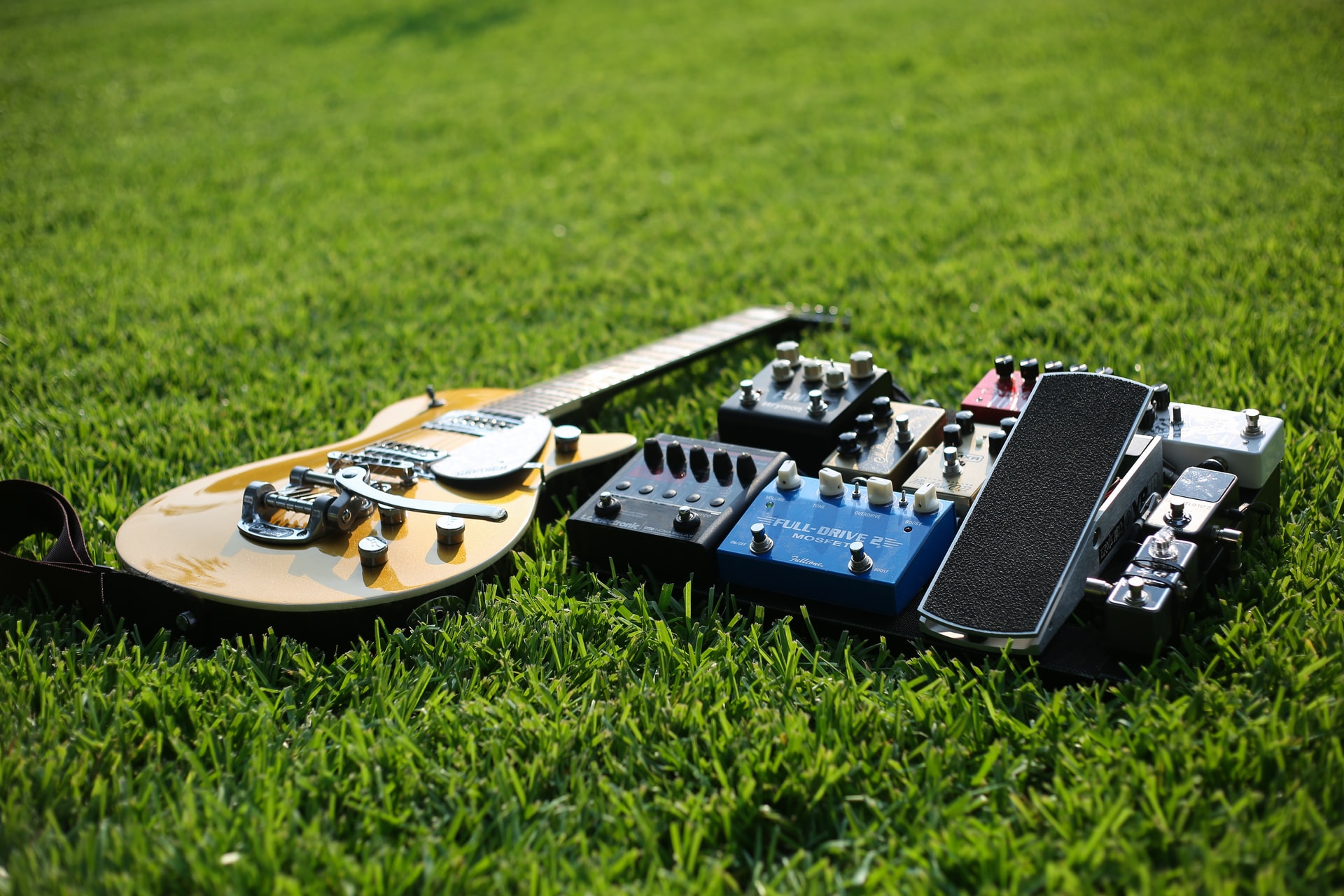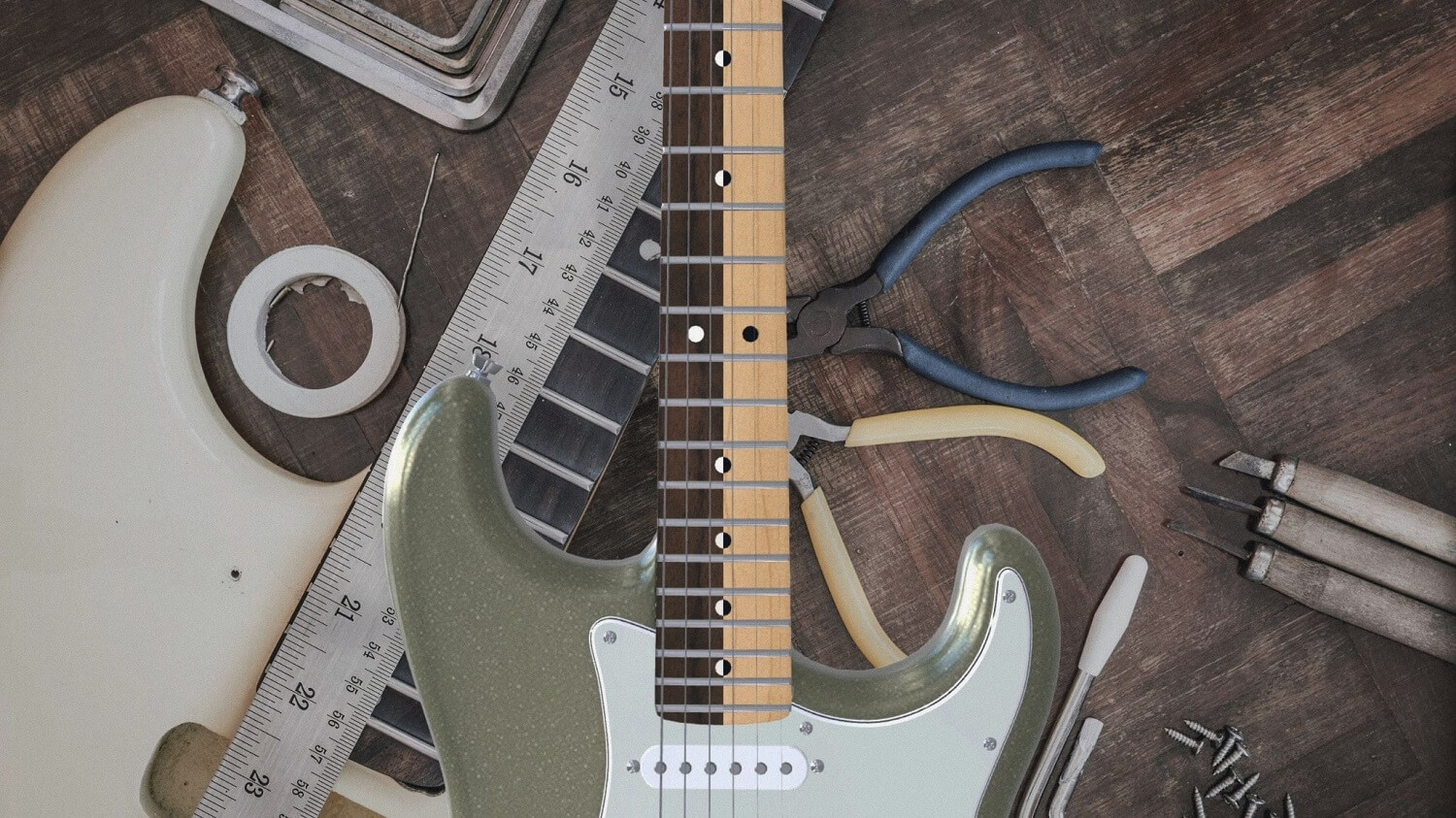Being among the most vital effects that could be used in music, delay and reverb are two great effects that when used the right way, could make your tone go to the next level.
Regularly, many people do not understand the real differences between the two, aside from what they hear when they play their guitars.
Yes, both delays and reverb make a huge presence and create a thicker sound, but how are they different? How do people use them?
Let’s talk about that right now in this article…
Table of Contents
- Differences between reverb and delay
- What is reverb?
- Types of reverb
- Taking a closer look at a Reverb guitar pedal
- What is a delay?
- Types of delays
- Key elements of a delay pedal
- Closely comparing the two: Reverb vs Delay
- Should you have one or the other? Should you have both?
- Which one of the two should you own?
- Reverb into Delay or Delay into Reverb
- Conclusion
Differences between reverb and delay
In short, reverb creates a sense of reverberation by replicating the sound of your guitar in an enclosed space; it can be used to simulate a sense of ambience or to add a sense of space to your sound. On the other hand, delay provides an echo-like effect by reproducing the sound of your guitar multiple times over a period of time; it can be used to create a sense of depth and spaciousness, as well as to add emphasis to certain notes or phrases.
Now, if you’d want to read a more in-depth take on this topic, I suggest you keep on reading!
I’ll go over the different types of both reverb and delay, which pedal type is better to own, and how and why they affect your guitar signal.
What is reverb?
Reverberation is defined as:
A prolongation of a sound; resonance.
That is the effect that makes the sound reflect back to you in different prolonged amounts of time and amplitude which creates a powerful echo.
A couple of usual reverb effects that are very known are Hall Reverb and Room Reverb.
Room Reverb would resemble playing the guitar in a small place like your bedroom, and Reverb Hall would be like playing your guitar in a concert hall.
The sound of the guitar would appear to bounce around the room, to then go back after being reflected by hitting a surface like a floor, roof, and pretty much any object.
Types of reverb
1. Room
Just like I mentioned before, a room reverb could imitate almost anything from a bedroom to a small music studio and everything in between.
This will give you the sensation of playing in a small place even when you are not.
Your guitar will sound as if the waves that you are producing are traveling a lot faster through the room, also making the decay quicker.
Room reverbs are known to have a warm sound.
2. Hall
Hall reverbs are more prominent as compared to room reverbs.
They produce a clear and spacious sound.
You will find out that most people will want their sound and tone to be fuller rather than appearing to come from a “small room” by using other types of reverb.
It is very used in modern music and sound production, for that reason alone.
As its own name describes, hall reverbs emulate the reverberation effect of large hall spaces like churches, and other large venues.
Because of their size, they have very long decay.
3. Cathedral or Church
Just like in the physical world, these spaces are regularly bigger as compared to almost any other type of reverb.
These tend to sound excessively large however the quality of your sound could really get affected in a negative way if you use it in the wrong way.
Especially when mixing different instruments, overusing this type of reverb tends to make everything sound bad and muddy, meaning with lack of clarity and definition with very poor separation between instruments.
4. Plate
A reverb plate is known to produce a very dense sound quickly and has no noticeable early reflections.
It produces a metallic-sounding reverb with an extended high-frequency range.
When it comes to recordings, plate reverbs are known to be one of the first types of artificial reverbs to be used.
According to sweetwater.com:
They used a steel plate under tension supplied by springs at the corners where the plate was attached to an outer shell. The plate gets vibrated in accordance with a signal from a transducer and the vibration is sensed elsewhere on the plate with a contact microphone of one type or another.
Now with digital pedals, it all becomes much more simple than that.
Taking a closer look at a Reverb guitar pedal
If you have had a reverb pedal before, you might have noticed that they all pretty much come with the same type of knobs, of course with a few exceptions.
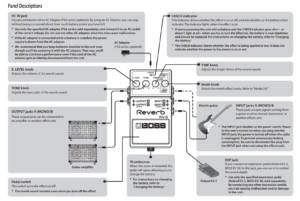
Source: Boss RV-6 Manual
- E LEVEL knob: Adjusts the volume of the reverb sound.
- TONE knob: Adjusts the tone color of the reverb sound.
- TIME knob: Adjusts the length (time) of the reverb sound.
- MODE knob: Selects the reverb effect mode.
- For all other input/output jacks, refer to the above picture.
This is what that same reverb pedal would look like:
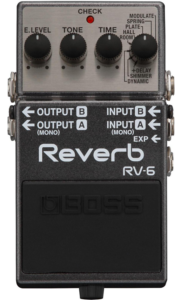
As you can see, it has most of the popular types of reverbs used nowadays (top rightmost knob) .
All the knobs, like the E Level, Tone, and Time, will let you control it to make it sound however you want.
Now…
What is a delay?
Fundamentally, a Delay is known to be unique sound signals that are delayed or postponed by certain units of time.
This concept is essentially called feedback:
- The number of times the delay sound is repeated.
The more the sound input, the higher the number of times the signal is rehashed, and, therefore, the longer the sound continues; this also depends on your pedal knobs settings.
According to Wikipedia:
The delayed signal may either be played back multiple times, or played back into the recording again, to create the sound of a repeating, decaying echo.
Simple delays make tracks sound bigger, larger, and have an interesting environment.
What are some different types of delays?
Types of delays
Let’s take a look at a Boss DD-8 manual, to see the type of delays you would expect to see in a delay pedal.
Note: These could always change from pedal to pedal.
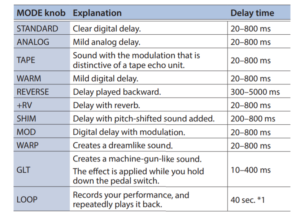
Source: Boss DD-8 Manual
As you can see, their MODE knob will give you various delay options.
1. Standard
The standard mode will give you just that, a standard delay.
Which is basically a clear digital delay with a delay time of 20–800 milliseconds.
You should use this delay mode if you want to make your guitar sound thicker, but at the same time, not have a very noticeable delay.
2. Analog
This pedal setting will give you a mild analog delay.
This mode will have a delay time of about 20–800 milliseconds
3. Tape
The tape delay mode will have a sound with the modulation that is distinctive of a tape echo unit.
A tape echo unit according to Roland.com:
Refers to the type of delay created by spools of magnetic tape in vintage effects units. They were the first-ever Delay units and the direct ancestor to today’s compact delay pedals.
This mode will give you a delay time of approximately 20 to 800 milliseconds
4. Warm
The warm delay mode will mildly sound like a digital delay.
Which will be accompanied by a softer sound.
It has a delay time of about 20 to 800 milliseconds.
5. Reverse
The reverse delay is simply a delay played backward.
This mode will provide psychedelic effects and many other unique tones.
Its delay time is about 300–5000 milliseconds.
6. +RV
The +RV delay mode will give you a 2 in 1 approach.
This mode will also add reverb to your delay, making it sound even fuller.
Its delay time will range from 20 to 800 milliseconds.
7. Shim
The shim delay mode will give you a pitch-shifted sound.
This could be used to add more texture to your tones and to simply make it sound a bit different.
Its delay time ranges from 200–800 milliseconds
8. MOD
The mod delay will simply be a digital delay with modulation.
Its delay time is about 20–800 milliseconds
9. Warp
The warp mode creates a dreamlike sound with delay times of about 20–800 milliseconds
10. GLT
Finally, the GLT mode gives a machine-gun-like sound to your guitar tone.
Its delay time is about 10–400 milliseconds.
Now…
All these delay modes will give you a clear understanding of what to expect in most of today’s delay pedals. There are many other types of delay, with each of them having different settings.
Some of them are the Slapback delay, Doubling delay, and Modulated Delay Types.
If you need an audio representation of these same modes, I encourage you to watch this short video!
You will be able to closely listen to what your guitar will sound if you use this same pedal, or even just have the idea in case you buy something different.
But…
What if the tone you hear in these types of delays is not exactly what you expect your guitar to sound like?
Of course, you would want to customize it to your own needs.
That’s why they all usually bring these options for you to make it sound just like you want.
Let’s take a look at a real delay pedal.
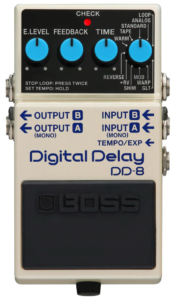
Typically, the delay pedal will offer you knobs that you can use to, for example, pan the audio to the right or the left of the mix, or even decrease or increase the delay feedback.
Key elements of a delay pedal
- LEVEL knob:
This adjusts the volume of the effect sound.
- FEEDBACK knob:
This adjusts the feedback level.
In other words, feedback is the number of times the delay sound is repeated.
- TIME knob:
This adjusts the delay time of your guitar.
Meaning, the amount of time that it takes to hear the first feedback of the audio, and then all the repeated ones afterward.
- MODE knob:
We were just talking about the different options this knob provides you.
This knob lets you control which type of delay your pedal is going to be giving to your sound or audio.
Now…
Aside from all these settings:
Sometimes, pitch shifting might be incorporated, channels to change harmonic content, groove modifications, distortion, or even LFO (Low-frequency oscillation).
Closely comparing the two: Reverb vs Delay
Okay, so you now know what reverb and delay are.
But how do you know the difference between them just by hearing a certain sound?
Think about it this way…
- A sound with reverb will reflect back to you in different prolonged amounts of time; think about a natural room echo.
- A sound with delay will reflect back to you with unique audio signals that are delayed or postponed by certain units of time.
If it is still not that clear, you should definitely watch this YouTube video:
It will show you real examples with voices and various ways in which music is currently being mastered by producers digitally.
Should you have one or the other? Should you have both?
You will find that most guitar players will have both reverb and delay pedals on their pedalboards.
There are always ongoing opinions and discussions about which one you should put after the other on your signal chain, but that is out of the scope of this post.
Would it be a good idea for you to make use of one of them over the other one?
If you are a beginner and simply trying out some new effects for your guitar, then you should definitely go with the one that will give you the most options; this can change from pedal to pedal.
But…
If you find yourself a pedal that will give you both delay and reverb settings, then go for that.
At the same time, in my opinion, it would also give you even more settings options if you have both types of effects in two different pedals.
Which one of the two should you own?
Answering this type of question can be really hard, and here is why. It all relies upon the result you’re looking for in your guitar tone.
Both reverb and delays are greater add-ons to your sound.
So, choosing one over the other will essentially make a big difference.
Both delays and reverbs are incredible effects for making depth and space in a soundtrack. You can make use of both in various approaches to help put sounds where you need them to be.
If you are a beginner and are looking to have some fun, then a delay pedal might do that for you and be the best choice.
On the other hand…
If you want a bit of a deeper tone, a reverb pedal will be a great choice, but again, delays could also help with that. So you can start to see why it is kind of hard to simply choose one over the other.
Reverb into Delay or Delay into Reverb
I wanted to leave you with this great YouTube video by Wampler Pedals.
In case you already have both delay and reverb pedals and you are wondering which one should go before or after in your pedalboard.
This video will let you make a good judgment of that by showing you how both settings will sound.
Conclusion
Delays and Reverbs play a transcendent rule in music creation.
Choosing one over the other is really hard as they both make serious contributions to your guitar tone.
Any track would sound dull or incomplete without the proper measure of delay and reverb added to it.

More than 10 years of experience playing and writing about guitars! When not writing, I can be found strumming away some Johnny Cash tunes. Favorite all time guitar is the Gibson Les Paul. #TeamGibson

